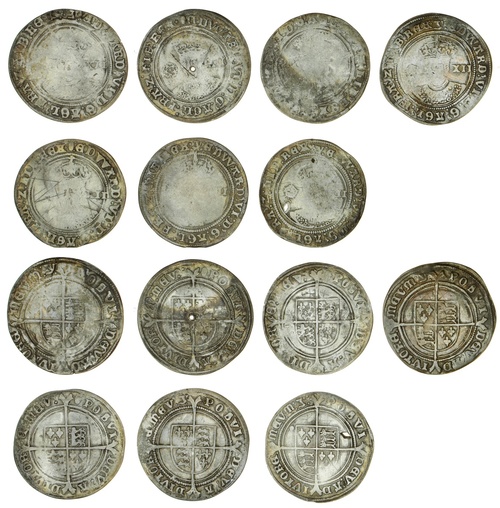
Auction: 20004 - British Coins and Commemorative Medals: Spring Auction - conducted behind CLOSED DOORS
Lot: 197
Edward VI (1547-53), 'Shovel-board' Shillings, third coinage, fine silver issue, Tower (7), m.m. tun (3), 5.72g, 8h, officially pierced in the 1696 Great Recoinage; another, 5.91g, 7h, incised graffito around head; also, 5.72g, 5h, incised asterices beside shield and saltires scratched above evidently to personalise this particular gaming piece; also, m.m.
The Shilling is now perhaps as distinctive of the British identity as the Royal family or her national beverage, but its introduction during the reign of Edward VI was merely a novelty that would have an unintended consequence for the traditional parlour game colloquially referred to as 'shove-groat'.
As the name suggests it originally relied on the circulating Medieval fourpence coin as the largest available 'counter' of the day. So popular was the game that it was omitted from the 'Unlawful Games Act of 1477' brought in to focus menfolks' idle hours on practicing bowmanship rather than frivolity. However, by 1522 members of the Inns of Court were to be prohibited from playing the game as well. Henry VIII continued to play the game as the accounts of the privy purse reveal his losing £9.0.0 and £45.0.0 at 'shovilla bourde' during the returns for 1532. Perhaps this is what ultimately prompted him to proscribe the game in the 'New Unlawful Games Act of 1541'.
However the introduction of the new twelvepenny coin a decade later would provide a perfect new gaming piece from which contemporary commentators could recount again this enduringly popular parlour game. William Shakespeare would relate: 'Quoit him down, Bardolph, like a shove-groat Shilling' in Henry IV, as well as tell of the unfortunate theft of 'two Edward shovel-boards' that had cost character Slender in The Merry Wives of Windsor 'two-shillings and two pence a piece'. Interestingly this also confirms the earliest known rules for the game, which required all players to have two gaming pieces.
However, John Taylor, the water-poet, writing in his 'Travailes of a Shilling' (London, 1621), provides the most vivid account of the game, and helpfully accounts for the abnormally high level of wear experienced on the head side of the coins, as well as the subsequent private markings encountered, which were evidently deployed as aids to distinguish individual player's pieces when cast on the table together.
“So much for that: now to my shape againe,
You see my face is beardlesse, smooth and plaine,
Because my Soveraigne was a child, ‘tis knowne
When as he did put on the English Crowne.
But had my stamp beene bearded, as with haire,
Long before this it had beene worne out bare;
For why with me the unthrifts every day,
With my face downewards do at shove-boord play,
That had I had a beard, you may suppose
Th’had worne it off, as they have done my nose.”
Intriguingly one of the coins presently offered displays a sharp lozenge shaped hole in the flan, which leads one to envisage the wider tactics of the game, and naturally the methods of cheating deployed to scupper an opponent's chances, such as that involving the sharp point of a trusty Tudor 'ballock' dagger!
Subject to 20% VAT on Buyer’s Premium. For more information please view Terms and Conditions for Buyers.
Sold for
£320
Starting price
£110




